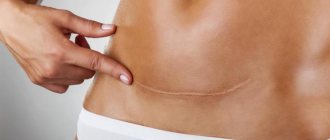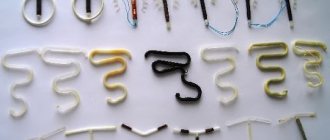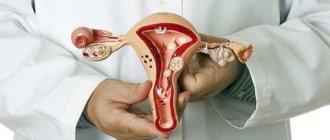“I want to install a spiral. Tell me, is this dangerous after a caesarean section? – similar questions are found on every thematic forum. The increased interest in this topic is easily explained. After all, an intrauterine device is one of the most effective ways to avoid an unplanned pregnancy after a cesarean section.
But it is worth considering that installing an IUD implies the introduction of a foreign body into the uterine cavity, where there is a scar that has not yet fully healed. Therefore, the question of the advisability of using this means of protection must be studied in detail.
Intrauterine device
Types and forms of intrauterine device
An intrauterine device (IUD) is a long-acting contraceptive that is inserted and fixed into the uterus. This is a small item made of copper and plastic that prevents sperm from entering the uterine cavity. The IUD also damages sperm and shortens the life span of the egg.
The intrauterine contraceptive includes:
- a body, the material of which depends on the type of “antennae” that is needed to remove the spiral from the uterus;
- tube through which the contraceptive is inserted.
Intrauterine devices come in several types.
Copper
Copper is released, which changes the fluid of the uterus and fallopian tubes, “killing” sperm.
This type can also prevent implantation of an already fertilized egg.
Gold or silver
Such contraceptives mechanically act on the epithelium of the uterus and prevent the fertilized egg from attaching to the uterine wall. During exposure to the uterine epithelium, a substance is released from the body of the spiral that reduces the motility and viability of sperm.
Types of spiral
Hormonal
The difference between hormonal IUDs and regular ones is that they come with a small reservoir containing the hormone levonorgestrel or progesterone. In addition to the fact that they perform a barrier function and prevent sperm from entering the uterus, they also have properties similar to birth control pills. Also, thanks to progesterone, the mucus inside the cervix becomes thicker and denser, preventing sperm from passing through.
The principle of operation of such spirals is that the hormone levonorgestrel “leaves” the reservoir daily and in equal quantities, thereby suppressing fertilization and implantation. Thus, there is additional protection against unwanted pregnancy. The hormone, in turn, does not penetrate into the blood and does not cause side effects such as nausea, weight gain, or dizziness. At the same time, gynecologists believe that hormonal devices are a more reliable contraceptive than conventional intrauterine devices. They also have a therapeutic effect, improving the quality of the endometrium.
Intrauterine devices come in different shapes:
- Ring-shaped - in the shape of the letter “O”, without visible “antennae”. This type of contraception is not recommended for nulliparous women and women after cesarean section.
- F-shaped - in the form of an “umbrella”, inserted painlessly and easily. This type is recommended for nulliparous women.
- T-shaped - this type is suitable for women of different ages, the spiral is easily and quickly inserted and removed.
Shapes of the spiral
Contraindications for inserting an intrauterine contraceptive device:
- erosion, fibroids, cyst;
- irregular cycle;
- pathology or anomaly of the structure of the uterus;
- infectious genitourinary diseases.
Functions of the intrauterine device
The function of the intrauterine contraceptive is almost 100% protection against unwanted pregnancy.
Pros of the IUD:
- protection against pregnancy by 98%;
- no further consequences for the woman’s reproductive system;
- quick and easy insertion and removal process;
- use during lactation;
- long period of validity;
- affordable price.
Disadvantages of the IUD:
- lack of protection against ectopic pregnancy;
- lack of protection against sexually transmitted infections;
- negative reaction of the body to body materials;
- restrictions for nulliparous women;
- heavy menstrual flow in the first months.
The table below shows the disadvantages and advantages of the IUD:
Pregnancy with an intrauterine device
Many women are concerned about the question of whether there is at least one percent of getting pregnant if there is intrauterine protection. This type of contraception fulfills its protective function by 98%. But there are 2% in which a woman can become pregnant. This may happen in the following cases:
- Using the spiral after the expiration date. The gynecologist will definitely warn you when you should come to replace the old device. It is better to do this a couple of months earlier, before the expiration date.
- Dropping out. It may happen that during menstruation, the intrauterine contraceptive slips out of the vagina. The gynecologist will show you how to check whether the IUD is in place, and at what time this should be done.
- Bias. If the intrauterine contraceptive deviates from its original position, the protective functions cease to function, and this may result in pregnancy.
How the IUD is inserted into the uterus
Before inserting the IUD, the gynecologist will refer the woman for an ultrasound examination and tests necessary to exclude contraindications. If everything is in order, on the recommendation of the gynecologist, the woman acquires one or another type and form of contraception. The procedure for inserting an intrauterine contraceptive takes no more than 15 minutes. During installation, a woman may feel painful and uncomfortable sensations. This is normal, but you definitely need to tell your doctor about it.
The insertion itself takes place on a gynecological chair. A gynecologist treats a woman’s genitals with an antiseptic. Next, the doctor opens and fixes the cervix. Using a special medical probe, the gynecologist takes measurements of the depth and direction of the uterus. Introduces the contraceptive into the uterine cavity through a guide tube. The last stage of installation is removing the conductor tube and cutting off the antennae.
At the request of the woman, for a more comfortable insertion of the spiral, the doctor can apply local anesthesia.
Installation of the spiral
Discomfort and pain may occur 1-2 days after installation of the intrauterine contraceptive device. This is considered the norm. A month after insertion of the IUD, you will need to come for an examination with a gynecologist. Next, a consultation examination will need to be done after 3 months and then every six months. This will allow the gynecologist to make sure that there are no complications after the procedure or, on the contrary, to detect the problem in time.
Urgently visit a gynecologist if the following symptoms are observed after administration:
- pain and discomfort during sexual intercourse;
- absence of “antennae” of the spiral when palpating them in the vagina;
- spiral loss;
- menstrual irregularities;
- stomach ache;
- discharge mixed with blood;
- feeling unwell: fever, dizziness, nausea, vomiting, diarrhea.
Caesarean section and IUD: when can it be installed?
Women who want to resume sex as soon as possible after giving birth worry about acceptable contraceptive methods. This is correct, because you can get pregnant almost immediately, and the absence of menstruation can be attributed to lactation or an unrecovered cycle. Therefore, you can insert an intrauterine device approximately a month or two after birth.
. This is exactly the time when, in the absence of complications, you can resume your intimate life.
If menstruation has already begun, it is best to place the IUD on days 1–7 of the monthly cycle. At this time, this procedure brings the least discomfort.
In some cases, there is a recommendation to install an IUD after six months
. This is especially true if a woman is supporting lactation. During this period, the lactational amenorrhea method can be used.
How to remove an IUD
The intrauterine contraceptive is removed within 5 minutes. The procedure is performed on a gynecological chair. The gynecologist treats the woman’s genitals with an antiseptic, then opens the cervix and fixes it. Using a special tool, grab the “tendrils” of the spiral and pull them towards you. The contraceptive is removed from the uterus.
The procedure is painless, after which a woman can lead an active lifestyle and plan a pregnancy, which can occur in 2-3 months. But complete restoration of the reproductive system takes about 1 year.
Life after caesarean section
A woman’s gradual recovery after surgical delivery occurs within 1-2 years. During this time, the muscle tissue in the scar area has time to heal.
In the first months, it is forbidden to lift weights so that the edges of the wound do not separate. The new mother may feel numbness in the area of the incision as nerves are cut during surgery. After 3 months, the discomfort disappears.
In the first 1.5 months, gynecologists recommend observing not only physical, but also sexual rest. Sexual life is allowed 6-8 weeks after cesarean section. During this time, the inner surface of the uterus heals, the size of the organ returns to its previous state. If a family is planning to have a child, the favorable period for pregnancy and childbirth is considered to be 2-3 years after the operation.
It is recommended to use reliable contraception for two years after a cesarean section, and the intrauterine device is one of the best options. To select and install an IUD, you should consult a doctor.
Contraindications
There are a number of diseases and pathologies in which a gynecologist may refuse to insert an IUD into a woman:
- diabetes;
- malignant tumors not only in the genitourinary system, but in the body as a whole;
- history of ectopic pregnancy;
- heart defect in a woman;
- uterine abnormalities, such as bicornuate uterus, underdeveloped uterus;
- sexually transmitted infections;
- inflammatory processes of the genitourinary system;
- uterine bleeding in the past;
- real pregnancy.
Malformations of the uterus
If a woman decides to get an IUD, she needs to consult a gynecologist. The doctor will conduct an examination and identify any contraindications for this procedure. At this stage, you should talk about all your diagnoses and health problems. Otherwise, the spiral will not fully perform its protective functions and may even harm the woman’s body.
Video: Benefits and harms of the intrauterine device
Side effects
Prolonged wearing of the IUD can provoke: • long and heavy periods, which can result in the development of anemia; there are frequent cases of bleeding after intimacy, in the middle of the monthly cycle; • development of endometritis - an inflammatory process of the walls of the uterus; • increasing the likelihood of ectopic pregnancy due to dysfunction of the fallopian tubes; • penetration of the vaginal microflora into the uterus through the open cervical opening, which can result in the development of an inflammatory process of the endometrium with the formation of polyps. The use of an intrauterine contraceptive is contraindicated for: • inflammatory diseases of the genitals; • tumors of any nature; • anemia, endometriosis, hyperplasia; • painful and/or heavy periods; • any diseases or traumatic disorders of the cervix. The spiral should be removed immediately in case of temperature reaction, bleeding, or general malaise. If wearing the IUD does not cause discomfort or pain, then you can use an intrauterine contraceptive for three to five years.











